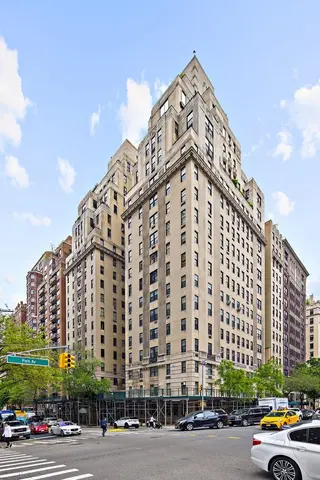 Carter Horsley
Carter HorsleyDec 23, 2011
Carter's Review
One of the most impressive apartment buildings on Park Avenue, 895 Park Avenue on the southeast corner at 79th Street is also one of the city’s better Art Deco buildings.
Massive but muted, it projects a dignified monumentality. It was designed by Sloan & Robertson, the architectural firm best known for the very prominent and important Chanin Building on the southwest corner of Lexington Avenue and 42nd Street.
The 19-story building was erected by Thos. O’Reilly & Sons in 1930 and converted to a co-operative in 1952.
It has 36 apartments.
Bottom Line
One of Park Avenue’s more prominent Art Deco buildings boasts squash and basketball courts and very nice decorative plaques.
Description
The building has a three-story limestone base beneath a yellow brick façade with wide fluted limestone pilasters.
It has an impressive entrance on 79th Street and several setbacks. The building has numerous decorative plaques, a very attractive enclosed rooftop watertank and consistent, multi-paned fenestration. A narrow portion of the building on the side-street is deeply recessed.
In his book, "The City Observed, New York, A Guide To The Architecture of Manhattan," (Vintage Books, 1979), architecture critic Paul Goldberger described this building as "interesting blend" of Georgian and Art Deco styles: "it is Park Avenue with just a hint of a 1930's flair."
Amenities
The building has a 24-hour doorman, an elevator operator, a squash court, a basketball court, storage and a fitness center.
Apartments
Apartment 18C is a three-bedroom unit with a 13-foot-entrance gallery with two north-facing windows and leads to the east to a 26-foot-long living room with wood-burning fireplace and to the west to a 22-foot-long dining room next to the 16-foot-square kitchen and a 12-foot-wide office. There is a north-facing, 52-foot-long terrace.
The A triplex on the 16th, 17th and 18tgh floors is a four-bedroom unit that has a 26-foot-wide entrance gallery that leads to a 19-foot-long garden room/library with a fireplace and a 26-foot-long west terrace, a 26-foot-long north terrace, and a 26-foot-long east terrace and to a 22-foot-long dining room next to a 10-foot-long pantry and a 15-foot-long kitchen with a 10-foot-long breakfast room on the lowest level, a 26-foot-wide gallery with staircase that leads to a 34-foot-long living room with fireplace and a bedroom on the middle floor and a 23-foot-long media room with a west bar and a 35-foot-long north terrace and a 58-foot-long west terrace, a 13-foot-wide study, a 12-foot-long laundry, and three bedrooms on the upper level.
History
Construction began in 1929 on the building, five years after its architect, John Sloan, had completed work on the building across the avenue at 898 Park Avenue.
In his March 12, 2009 “Streetscapes” column in The New York Times on the two buildings, Christopher Gray noted that 895 had a “chauffeurs’ room” and “no dropped beams in the entertaining rooms – the lateral steelwork had been pushed back to the edges so that they were within the walls.”
“Promotional materials puffed the attention given to rooms for staff members – turnover was a constant headache- but plans show typical Park Avenue servants’ rooms, with no closet, room only for a bed and a dresser, and a shared bath down the hall, and that with a half-tub.”
“In 1930,” the article continued, “The Architectural Forum praised No. 895’s ‘delightful simplicity,’ a conservative mix of traditional forms and modernism often now classicizing
Art Deco. The cornice above the 12th floor has wide rectangles of stone underneath, but far larger than the forms called modillions of traditional cornices. The vertical elements - broad, fluted pilasters – are well in from the corners, rather than at the edges of the building, as was standard. Only a few apartments were sold, and Mr. Sloan was living in his creation when it went into foreclosure in the spring of 1931 and was then converted to rental. An advertisement for No. 895 in The New Yorker in early 1932 showed a picture of a suave man in white tie and the legend ‘the rich are economizing wisely.’ In 1952, tenants bought the building for $2 million and reconverted it to a co-op. No. 895 has changed little since construction, and even has most of its original windows.”
An August 2, 1931 article in The New York Times said that the building, “originally designed to be one of the finest cooperative houses in the city, will be sold at foreclosure auction next Tuesday,” adding that “one or two suites in the building were sold, but while ready for occupancy last Fall the structure has been practically empty and last Spring the suites were offered on a rental basis.”
Location
Its location is in the heart of the Upper East Side, close to Fifth Avenue's "Museum Mile," the fashionable boutiques and art galleries of Madison Avenue and numerous restaurants nearby on Third Avenue and the 77th Street local station of the Lexington Avenue Subway.

- Co-op built in 1930
- 2 apartments currently for sale ($495K to $14M)
- 1 apartment currently for rent ($10.5K)
- Located in Park/Fifth Ave. to 79th St.
- 36 total apartments 36 total apartments
- 10 recent sales ($4.7M to $24M)
- Doorman
 6sqft delivers the latest on real estate, architecture, and design, straight from New York City.
6sqft delivers the latest on real estate, architecture, and design, straight from New York City.
